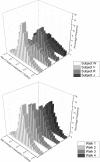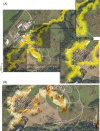A new perspective on how humans assess their surroundings; derivation of head orientation and its role in 'framing' the environment
- PMID: 26157643
- PMCID: PMC4476166
- DOI: 10.7717/peerj.908
A new perspective on how humans assess their surroundings; derivation of head orientation and its role in 'framing' the environment
Abstract
Understanding the way humans inform themselves about their environment is pivotal in helping explain our susceptibility to stimuli and how this modulates behaviour and movement patterns. We present a new device, the Human Interfaced Personal Observation Platform (HIPOP), which is a head-mounted (typically on a hat) unit that logs magnetometry and accelerometry data at high rates and, following appropriate calibration, can be used to determine the heading and pitch of the wearer's head. We used this device on participants visiting a botanical garden and noted that although head pitch ranged between -80° and 60°, 25% confidence limits were restricted to an arc of about 25° with a tendency for the head to be pitched down (mean head pitch ranged between -43° and 0°). Mean rates of change of head pitch varied between -0.00187°/0.1 s and 0.00187°/0.1 s, markedly slower than rates of change of head heading which varied between -0.3141°/0.1 s and 0.01263°/0.1 s although frequency distributions of both parameters showed them to be symmetrical and monomodal. Overall, there was considerable variation in both head pitch and head heading, which highlighted the role that head orientation might play in exposing people to certain features of the environment. Thus, when used in tandem with accurate position-determining systems, the HIPOP can be used to determine how the head is orientated relative to gravity and geographic North and in relation to geographic position, presenting data on how the environment is being 'framed' by people in relation to environmental content.
Keywords: Environmental framing; Head attitude; Navigation behaviour.
Conflict of interest statement
The authors declare there are no competing interests.
Figures













References
LinkOut - more resources
Full Text Sources
Other Literature Sources

